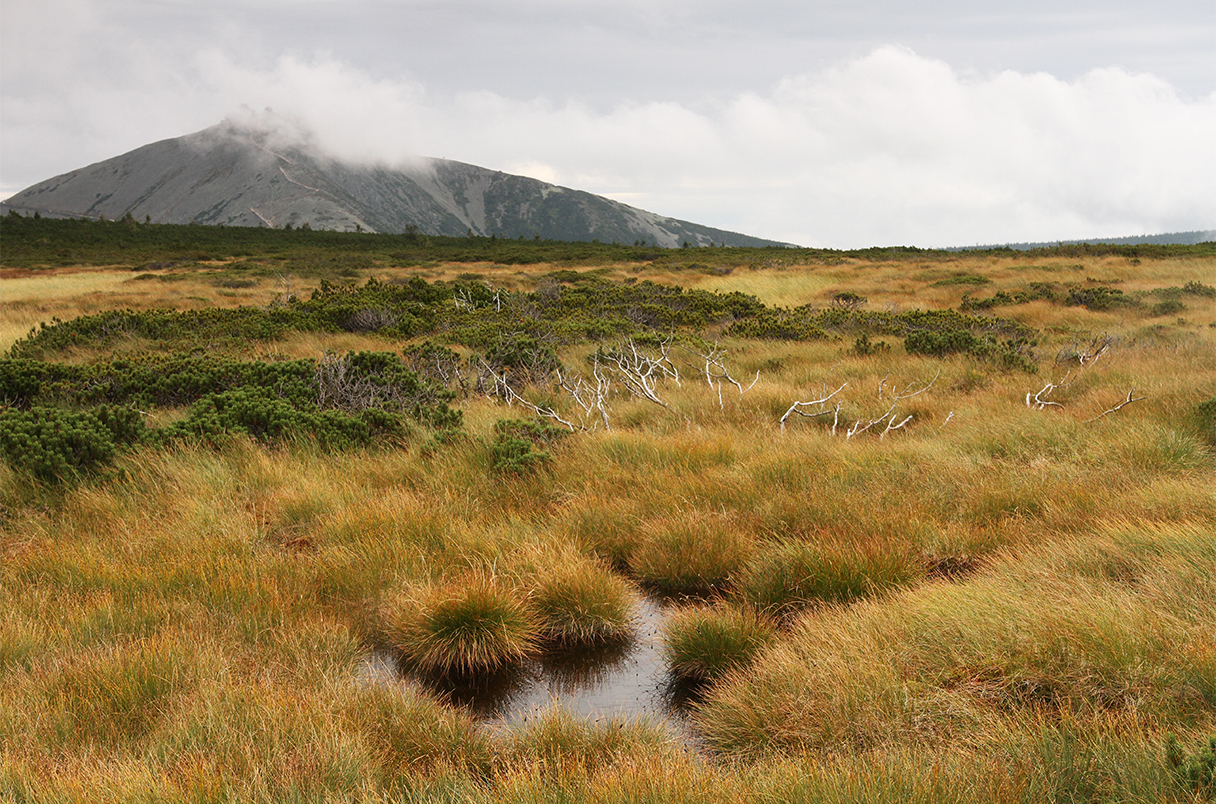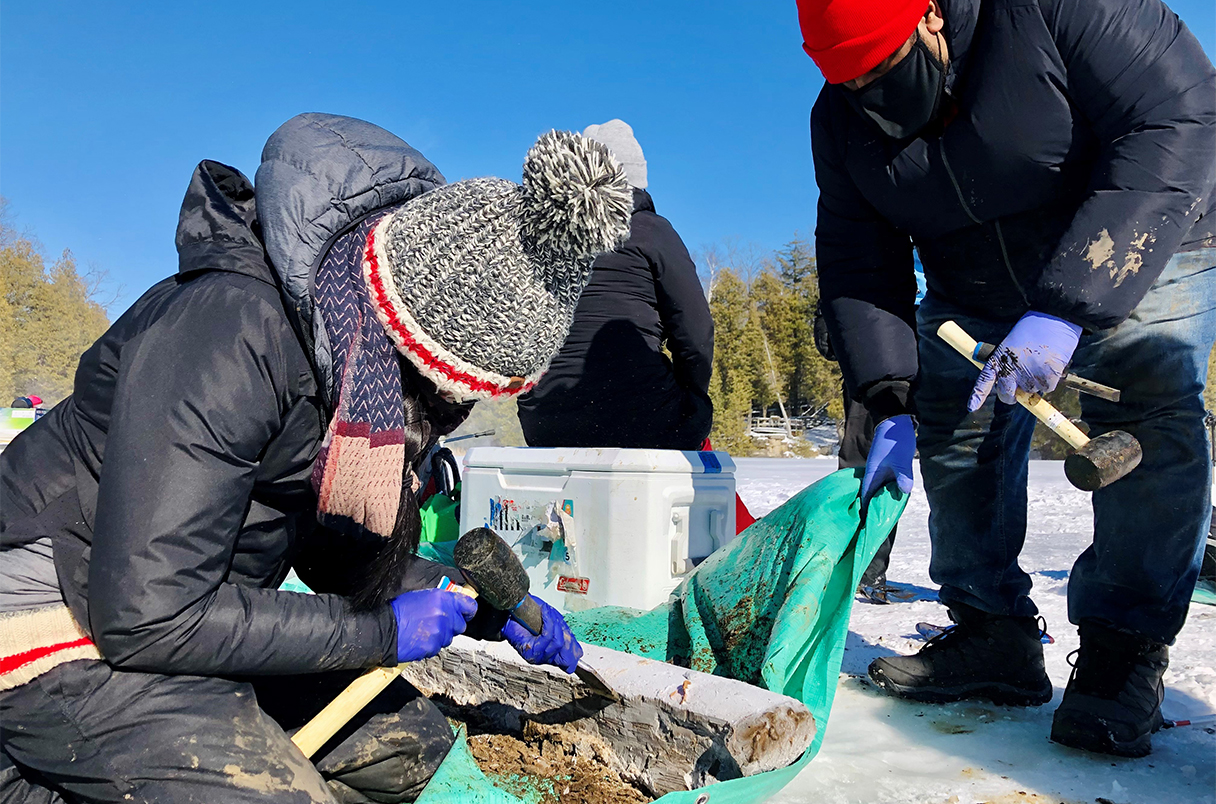Bogs, lakebeds, and sea floors compete to become Anthropocene’s ‘golden spike’

Peat layers in Poland’s Śnieżka bog capture spikes in plutonium from nuclear tests, jumps in metals from nearby smokestacks, and the extinction of native amoebas.MAREK DOBROWOLSKI
If you had to pick one spot that best reflects when human activity became an Earth-shaping force, where would it be? Geoscientists will consider the question this month when they meet to evaluate 12 sites, only one of which can serve as the “golden spike” for the Anthropocene, a proposed geological age beginning in the 1950s amid the fire of nuclear bomb tests and the fumes of surging fossil fuel use.
Although the idea of the Anthropocene has gained wide traction, it still lacks a formal geological definition. In 2016, the Anthropocene Working Group (AWG), a group of several dozen geoscientists convened by the International Commission on Stratigraphy (ICS), settled on the early 1950s as its starting point. But the ICS still needs a formal proposal with an ideal geologic sample recording these global changes—a golden spike—to mark the end of the Holocene epoch, which began 11,700 years ago, and the beginning of the Anthropocene.
To find that sample, teams of earth scientists spent several years analyzing sites that contain promising markers, such as spikes in plutonium and other radionuclides that settled after atmospheric nuclear tests, spherical ash particles from unchecked industrial emissions, microplastics, and perturbations to carbon and nitrogen chemistry from greenhouse gas emissions and urban smog. The array of possibilities was bewildering, says Colin Waters, a geologist at the University of Leicester and AWG chair. “Starting from scratch, you’ve got the whole world to play with.”
At a meeting in Berlin, starting on 18 May, the teams will present the case for their site to serve as the golden spike. Months of deliberation will begin this summer, before a final silent voting period. If 60% of the group’s members agree on one site, a selection will be announced by December, Waters says.
Some of the strongest candidates come from lake bottoms that accumulate muds in thin annual layers, creating high-resolution records. Crawford Lake in Canada’s Ontario province, only some 200 meters wide but 25 meters deep, is one. In cores of mud from the lake, changes seen since the 1950s stand out vividly, including the bomb spike and an “off the charts” increase in soot from local industry, says Francine McCarthy, a micro-paleontologist at Brock University. “We have a really ideal site,” she says.

Scientists from Carleton University removing sediment from the freeze corer.
This freeze core is now archived at the Royal Ontario Museum in Toronto.CONSERVATION HALTON
A site outside Europe or North America, which industrialized well ahead of other regions, might be a better record of changes that swept the world in the 1950s, says Yongming Han, a geochemist at the Chinese Academy of Sciences’s Institute of Earth Environment. His team will propose Sihailongwan Lake, in a protected forest in northeastern China. Mud cores from the lake show not only the bomb spike and rises in soot, but also increases in spherical ash particles and heavy metals. They also record a rapid increase in light carbon, the isotope favored by life, driven by burning fossil fuels that were once organic matter.
There is no greater aggregator of global signals than the ocean, making marine sediments strong contenders. One set of muds, collected in the Baltic Sea, shows a pronounced change from light gray to dark brown in the 1950s, the result of algal blooms fed by fertilizer in farming runoff. “There’s an explosion” of algae, says Jérôme Kaiser, a marine geochemist at the Leibniz Institute for Baltic Sea Research. His team sees not only the bomb spike and surge of spherical ash, but also a rise in DDT, a once-ubiquitous pesticide. Meanwhile, in Japan, sediment samples from Beppu Bay show an increase in total nitrogen from fertilizer runoff around this time, says Michinobu Kuwae, a paleoceanographer at Ehime University. “Humankind must notice that we are already in the Anthropocene,” he says.
Corals are another ocean record under consideration, but they have been a bit less fruitful, says Kristine DeLong, a paleoclimatologist at Louisiana State University, Baton Rouge. Although the coral she studied from a pristine reef in the Gulf of Mexico did capture the plutonium and radiocarbon of the bomb spike, other fallout products, like cesium-137, aren’t present. “It’s kind of nice, these corals weren’t impacted,” she says. What they do display are strange increases in barium—likely from barite, a mineral used in offshore oil drilling.
A late addition to the slate of candidates came from a Polish peat bog near a mountain summit in a region known for its mines and heavy industry. The bog is fed only by rain, so it forms a great archive of atmospheric pollution, says Barbara Fiałkiewicz- Kozieł, a geoecologist at Adam Mickiewicz University. Its sediments capture the typical 1950s markers, along with spikes in lead, aluminum, titanium from nearby smokestacks—and even the extinction of amoebas that once thrived in the peat. “I have 30 different proxies,” she says. “And every proxy gives a very distinct answer.”
Marking time
By December, a winner could emerge from
12sites competing to be the Anthropocene’s “golden spike.”
But its adoption by the bureaucracy that governs
geologic time is not guaranteed.
| NAME | LOCATION | TYPE |
| Beppu Bay | Kyushu Island Japan | Marine sediments |
| Crawford Lake | Ontario, Canada | Lake muds |
| Ernesto Cave | Italy | Cave deposits |
| Flinders Reef | Coral Sea, Australia | Coral |
| Gotland Basin | Baltic Sea | Marine sediments |
| Palmer ice core | Antarctic Peninsula | Ice sheet |
| San Francisco Estuary | California, United States | Marine sediments |
| Searsville Reservoir | California, United States | Lake muds |
| Sihailongwan Lake | Jilin province, China | Lake muds |
| Śnieżka bog | Poland | Peat layers |
| Vienna Museum excavation | Austria | Urban soil |
| West Flower Garden Bank | Gulf of Mexico | Coral |
After the AWG settles on a site, the proposal must be approved by 60% of the two dozen or so members of the Subcommission on Quaternary Stratigraphy. From there it will go to the executive committee of the ICS—and finally to the International Union of Geological Sciences (IUGS). These are not rubber stamps; proposals for stratigraphic divisions routinely fail, and when they do, they cannot be reconsidered for 10 years. “There’s no guarantee that the Anthropocene will be agreed upon,” says Jan Zalasiewicz, a Leicester stratigrapher and longtime AWG head who now leads the quaternary subcommission. “There are influential stratigraphers who are very uncomfortable with a formalized Anthropocene.”
One of those stratigraphers is IUGS head Stanley Finney of California State University, Long Beach. From the start, he says, the AWG has operated backward, starting with the proposed Anthropocene and looking for markers, rather than starting with the geologic record itself. The group “has not been open-minded,” he says. In his view, the Anthropocene should not be shoehorned into the record of geologic time because, so far, it is just one human lifetime long, based on centimeters of mud and signals that may not persist once those sediments turn into rocks. Even the plutonium will be largely undetectable after 100,000 years.
Despite his personal opposition, Finney says he won’t stand in the way if the ICS is open and follows procedure. But he would prefer to categorize the Anthropocene as an “event,” an informal term geoscientists use for everything from gradual planet-wide changes that take millions of years to large asteroid impacts. Waters agrees the Anthropocene can be an event, but argues that shouldn’t preclude a more formal designation. He points out how the dinosaur-killing Chicxulub impact 66 million years ago is an event—but also one that marks the geological divide between the Cretaceous and the Paleogene periods.
AWG member Erle Ellis, a landscape ecologist at the University of Maryland, Baltimore County, believes the odds of approval for an Anthropocene epoch aren’t great, but says the “event” idea could fare better. For years, the ICS has fretted about provoking negative publicity if it rejects the Anthropocene proposal. With an “event,” Ellis says, the ICS can still acknowledge the significant impact that humanity is making on Earth. “The Anthropocene is never going to be rejected,” he says. “It’s simply a matter of how it’s going to be defined.”
Correction, 6 May, 1:15 p.m.: A previous version of this story incorrectly stated that a coral site in the Gulf of Mexico did not pick up the bomb spike at all.
附件下载:
